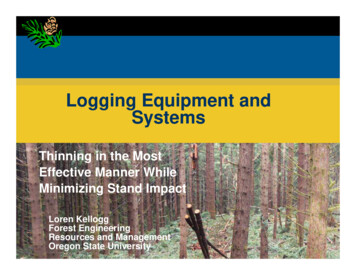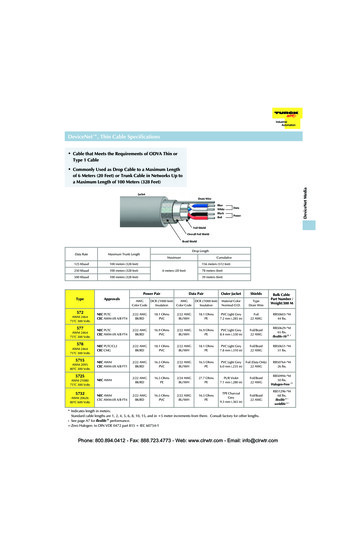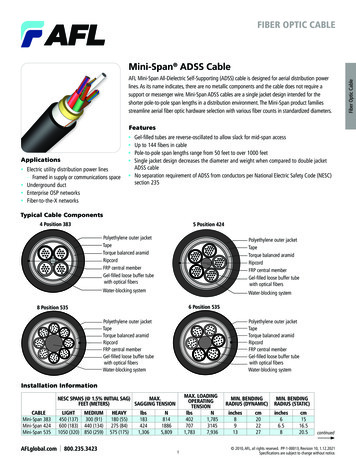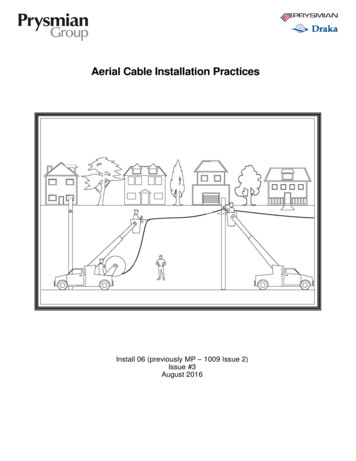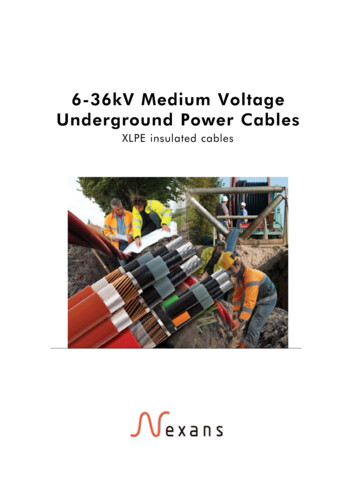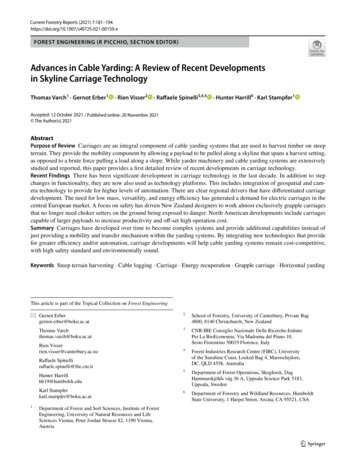
Transcription
Current Forestry Reports (2021) 0-xFOREST ENGINEERING (R PICCHIO, SECTION EDITOR)Advances in Cable Yarding: A Review of Recent Developmentsin Skyline Carriage TechnologyThomas Varch1 · Gernot Erber1· Rien Visser2· Raffaele Spinelli3,4,5· Hunter Harrill6 · Karl Stampfer1Accepted: 12 October 2021 / Published online: 20 November 2021 The Author(s) 2021AbstractPurpose of Review Carriages are an integral component of cable yarding systems that are used to harvest timber on steepterrain. They provide the mobility component by allowing a payload to be pulled along a skyline that spans a harvest setting,as opposed to a brute force pulling a load along a slope. While yarder machinery and cable yarding systems are extensivelystudied and reported, this paper provides a first detailed review of recent developments in carriage technology.Recent Findings There has been significant development in carriage technology in the last decade. In addition to stepchanges in functionality, they are now also used as technology platforms. This includes integration of geospatial and camera technology to provide for higher levels of automation. There are clear regional drivers that have differentiated carriagedevelopment. The need for low mass, versatility, and energy efficiency has generated a demand for electric carriages in thecentral European market. A focus on safety has driven New Zealand designers to work almost exclusively grapple carriagesthat no longer need choker setters on the ground being exposed to danger. North American developments include carriagescapable of larger payloads to increase productivity and off-set high operation cost.Summary Carriages have developed over time to become complex systems and provide additional capabilities instead ofjust providing a mobility and transfer mechanism within the yarding systems. By integrating new technologies that providefor greater efficiency and/or automation, carriage developments will help cable yarding systems remain cost-competitive,with high safety standard and environmentally sound.Keywords Steep terrain harvesting · Cable logging · Carriage · Energy recuperation · Grapple carriage · Horizontal yardingThis article is part of the Topical Collection on Forest Engineering* Gernot Erbergernot.erber@boku.ac.atThomas Varchthomas.varch@boku.ac.atRien Visserrien.visser@canterbury.ac.nzRaffaele Spinelliraffaele.spinelli@ibe.cnr.itHunter Harrillhh19@humboldt.eduKarl Stampferkarl.stampfer@boku.ac.at12School of Forestry, University of Canterbury, Private Bag4800, 8140 Christchurch, New Zealand3CNR-IBE Consiglio Nazionale Delle Ricerche-IstitutoPer La BioEconomia, Via Madonna del Piano 10,Sesto Fiorentino 50019 Florence, Italy4Forest Industries Research Centre (FIRC), Universityof the Sunshine Coast, Locked Bag 4, Maroochydore,DC, QLD 4558, Australia5Department of Forest Operations, Skogforsk, DagHammarskjölds väg 36 A, Uppsala Science Park 5183,Uppsala, Sweden6Department of Forestry and Wildland Resources, HumboldtState University, 1 Harpst Street, Arcata, CA 95521, USADepartment of Forest and Soil Sciences, Institute of ForestEngineering, University of Natural Resources and LifeSciences Vienna, Peter Jordan Strasse 82, 1190 Vienna,Austria13Vol.:(0123456789)
182IntroductionIn its wider sense, a carriage is a wheeled device capable of moving a load on a pre-determined path. The termis generally applied to railway cars or to horse-drawncoaches [1], but it is not exclusive to them. The same termis applied to cable yarding, with the main difference thatthe path is a cable and not a track, and the load is suspended under the carriage and not on top of the carriageitself [2] (Fig. 1). Using this definition, the first implication is that carriages are specifically associated withskyline yarding systems [3], while in all other cases, acommon term is “butt rigging”—not a carriage proper [4].Skyline carriages can be described and classified in several ways. Essentially, a carriage performs three functions:it moves, it stops, and it provides the opportunity to reachand attach a load. Therefore, it can be described based onFig. 1 Basic diagram of askyline cable yarding systemin an uphill (A) and a downhill(B) yarding setting, showing (a)yarder, (b) skyline, (c) anchors,(d) carriage with chokers connecting to the load, (e) mainline,and (f) haulback line (after [5],adapted)13Current Forestry Reports (2021) 7:181–194how it moves, how it stops, and how it reaches its loadand connects to it (Fig. 2). The carriage’s functions arealso represented by the work elements into which a yarding cycle is commonly divided in work studies: outhaul,hook-up or loading, inhaul, and unhook or unloading [6].Carriage movement along the skyline and towards theyarder is achieved using a cable called the mainline. Carriage movement back out to the loading area along the skyline may be solely from the assistance of gravity (gravitycarriages) or be independent of it (non-gravity or all-terraincarriages). In the latter case, movement is obtained by anadditional winch and cable called the haulback line. As theirname implies, all-terrain carriages are more versatile thangravity carriages but generally more complex and expensive.An exception to the mainline/haulback system is the selfpropelled carriage, where a built-in motorized drive systempulls the carriage along the skyline. As to the type of track(skyline) the carriage can move along, the main distinction
Current Forestry Reports (2021) 7:181–194183Fig. 2 Classification of carriages by way of movement, stopping, reaching and connecting to loads and pulling slackis between single-span and multi-span carriages. The latterhave an open structure and can pass over intermediate supports, while the former have an enclosed structure and muststop in front of a support [7].Regarding the carriage stopping and remaining in placeat the loading points and the landing, the simplest optionis to brake the cable that prevents gravity from moving thecarriage away (unclamped carriages). A carriage can alsohold fast to the skyline by a built-in clamp (self-clampingcarriages) or by a separate stop placed along the skyline.When it comes to reaching loads, the simplest carriagesonly allow to retrieve those loads that are located directlybelow the skyline. This usually requires the skyline to belowered with the carriage and limits efficient deployment toclear-cut operations [8]. This is because the weight of theskyline, carriage, and other rigging equipment is too heavyfor the forest worker on the ground to move. A carriage thatfacilitates the extraction of material further away from thecarriage is referred to as a “slack-pulling” carriage—that is,a carriage capable of lateral yarding.Lateral yarding capacity allows for a wider spacing ofskyline corridors and grants the benefit of less frequent lineshifts [9]. Carriages with lateral yarding capacity can beused in any type of silvicultural treatment and are particularly suited to operations where residual trees need to beprotected from yarding damage [10, 11]. Non-lateral yarding carriages can connect to their loads through chokers orgrapples. All lateral yarding carriages use chokers as it isdifficult to move a heavy full-size grapple any distance fromdirectly under the skyline.Lateral yarding is achieved by a segment of rope referredto as the “dropline,” which can be the same mainline orhaulback line or a separate line being spooled out from adrum mounted in the carriage. Under specific conditions, adropline can be paid out by gravity, but it is far more common on modern carriages to be supported by some mechanical device. Slack can be pulled mechanically by the yarderthrough a dedicated line or by a motor mounted in the carriage in the case of motorized slack-pulling carriages. If thedropline is contained in a separate built-in motorized winch,then one will talk about a motorized dropline carriage [8].Finally, payload capacity is used for discriminating betweenlight, medium or heavy carriages [12]. Operators of cableyarders can choose from a very wide range of types andmodels, all of which can be described through the abovementioned attributes.Modern-day skyline carriages are the result of a longevolution that begun shortly after their first documentedappearance in 1886 [13]. Within very few years (1891),slack-pulling was introduced [13], which has been refinedthrough increasingly sophisticated and functional triggermechanisms and powering devices [14]. Adoption of radiocontrol in the 1960s [15] enabled alternating control of thecarriage by the yarder operator and the choker setter [14].Further, radio control was instrumental in the developmentof grapple carriages in 1970s that allowed loads to be picked13
184up without a worker on the slope and thus made it possibleto cope with workforce shortages [15]. Implementation ofautomation of carriage movement in the 1980s and 1990sconstituted a further major step in carriage technology development. It enabled automated movement between the loading points and the landing stations, where the carriage wouldstop automatically and wait for further commands. Thereby,the yarder operator and the choker setter were spared fromcontrolling the carriage during travel and could engage inother more productive work tasks [14].Carriage technology has evolved substantially over thelast decade in response to recent challenges in steep terrain harvesting. These have included labor shortage, strictersafety standards, rising fuel cost, and increasing environmental restrictions [16 , 17 , 18–20]. Therefore, pastreviews of skyline carriage technology [8, 21] may no longerreflect the current state of the art. Glimpses of new carriagetechnology are offered individually by ad hoc papers thatoften consider carriage innovation within the context of thecable yarding systems rather than focusing on carriage specifics. Lack of focus and fragmentation of results contributeto partially obscure the considerable progress achieved in thespecific field of skyline carriage technology, despite recentand notable innovation.This paper aims to highlight recent progress in carriagetechnology and illustrate how some skyline carriage manufacturers in Europe, New Zealand, the Western UnitedStates, and Canada have reacted to the new demands forbetter fuel efficiency, improved environmental performance(e.g., lower fuel consumption, extraction on sensitive soils),and increased worker safety.MethodologyTo this end, scientific literature databases (Web of Science,Scopus, Google Scholar) were searched for peer-reviewedpublications by combining the mandatory search term “carriage” (in title, abstract, or keywords) with variations andcombinations of “logging,” “cable,” and “yarding.” Thesearch was limited to studies published over the last 2 decades, with a preference for those from the last 10 years.Results were then screened for studies that specificallyaddressed the carriage and its effects. In addition, otheronline literature databases (e.g., Forest Growers ResearchLtd. or the US Forest Service’s Treesearch) and practicaljournals (e.g., the Austrian “Forstzeitung,” the German“Forstmaschinenprofi”) were scoured for materials onthe subject. Finally, the search was complemented by theauthors’ personal collections of scientific articles, books,and reports. From the collected materials, trends in skylinecarriage technology over the last 10 to 20 years were identified, and three major ones were selected by the author group13Current Forestry Reports (2021) 7:181–194for presentation in this publication: energy-recuperatingslack-pulling carriages, double-hitch carriages, and grapple carriages. In addition, manufacturers of these carriageswere contacted for technical details on the carriages, whichwere merged into overviews of the carriage models currentlyavailable on the market.ResultsBetter Fuel Efficiency: Energy‑RecuperatingSlack‑Pulling CarriagesOver the last 2 decades, slack-pulling carriages have reacheda high level of maturity [14]. Change and improvements tothe designs were mostly incremental in nature, e.g., replacement of engines to comply with emission regulations. Theintroduction of energy recuperation systems by several European manufacturers was an exception to this. The rationalewas to increase the operational and ecological efficiency ofcable yarding by recuperating some of the energy that needsto be dissipated when moving cables, carriage, and load(e.g., applying braking forces to the drums). This can thenbe used to replace power supply from fossil fuels. Fossil fuelconsumption ranks among the top three entrepreneur concerns [17 , 20], and fuel cost represents up to 20% of totalsystem cost in cable yarding [22]. With respect to carriages,developments specifically aimed at replacing combustionengine drives for slack-pulling devices by drives poweredby recuperated energy.In mechanical engineering, “recuperation” refers to processes by which kinetic or thermal energy can be recovered,usually in converted form, and stored in dedicated storagemedia. Converted forms are electrical or hydraulic energies,and accumulators, capacitors, and hydro-pneumatic pressureaccumulators can be used for storage [23]. The first recuperation systems were developed for racing cars and becameoperational in 1996. These systems used a generator to recuperate braking energy, which otherwise would have had to bedissipated as heat through brake discs. Recuperated energywas then used for boosting acceleration [24]. Today, thesame technology is used in passenger cars to increase fuelefficiency by temporally replacing the combustion enginedrive by an electric one [25–27].Early examples for the use of energy recuperation technology in skyline carriages include the BK-25 E carriage(Gantner, Sulz, Austria) and the HASK 3500 carriage, thelatter designed by Stuefer (Langkampfen, Austria) [14]. In2002, Greifenberg constructed a fully electric carriage (Ht30) that was powered by energy recuperated during movement of the carriage. However, technical problems caused bythe lesser sophistication of the electro-hydraulic componentsavailable at the time resulted in the electrical recuperation
Current Forestry Reports (2021) 7:181–194185system being replaced by a hydro-pneumatic one (mail fromGreifenberg D, Greifenberg Teleferiche SAS, Mar 2021). Inthe 2010s, other manufacturers followed: Franz Hochleitnerwith the Bergwald 5000 Hybrid and Prysis with the CableCar 30 in 2012; Koller, who had acquired Stuefer in 2007,with the ESK 2.0 in 2015; and Konrad with the E-Liner[28–32]. In 2018, Schilter presented the SE 4000 [32]. Inthe same year, Mayr-Melnhof launched the Sherpa UE series[32] and then also acquired Prysis in 2020 [29]. As of April2021, 6 manufacturers offer 13 different types of energyrecuperating carriages (Table 1).Energy for powering slack-pulling is recuperated eitherduring movement of the carriage, during loading, or both.In the first case, this is achieved by radial piston pumps orgenerators connected to the skyline sheaves. Such devicesare currently included in only two carriages, being the MayrMelnhof PRYSIS H3 and Greifenberg Ht 30. In most cases,energy is recuperated during the movement of the load andmore precisely during lateral yarding (Table 1). To this end,the line to which the load is attached is run over a tractionsheave inside the carriage, and the sheave is connected to acombination of electrical generator and engine. Thus, whenthe line is pulled in during lateral yarding, the device’s generator functionality is used for recuperating energy, whileits engine functionality is used for slack-pulling during thesubsequent cycle. In addition to lateral yarding, the Schilterand Koller carriages recuperate energy during loweringof the load ([41], conversation with Gschwenter C, KollerForsttechnik GmbH, Mar 2021). For Konrad carriages, thisfeature is only available as an option [35]. The Koller ECKOBOOST carriage offers a further feature: during lateral yarding, energy recuperation can be suspended, and the slackpulling device can be used to enhance lateral yarding pullby up to 20%, if required [33]. While all other energy-recuperating carriages are independent designs, existing MayrMelnhof Sherpa carriages can be retrofitted with the energyrecuperation and energy storage unit to become Sherpa UEtypes [37].Accumulators (n 5) and supercapacitors (n 6) are themost frequently used type of energy storage media in energyrecuperating carriages, while hydraulic accumulators (n 2)are less popular (Table 1). Accumulators are rechargeableenergy sources that differ in structure, design, material,and chemical components and consist of at least two cells,usually arranged in series [42, 43]. Carriage designs whereaccumulators (usually lithium-ion types) are used cannotbe operated self-sufficiently. In this case, energy recuperation extends operating time, but recharging of the accumulators by external sources is required after one to two days ofoperation (conversation with Herzog J, Franz HochleitnerGmbH, Apr 2021, mail from Vilsmeier A, Mayr-MelnhofForsttechnik GmbH, Apr 2021). On the contrary, capacitorsTable 1 Energy-recuperating carriages by manufacturer, energy recuperation system, payload, mass, and line payout forceManufacturerCarriage modelEnergy recuperationsystem/recuperationduringRecuperated energystored inPayload Carriage mass Line payout forceKoller ForsttechnikGmbH (Schwoichbei Kufstein, Austria)[33, 34]Konrad ForsttechnikGmbH (Preitenegg,Austria) [35, 36]Mayr-MelnhofForsttechnik GmbH(Frohnleiten, Austria)[37, 38]ECKO UPECKO FLEXECKO BOOSTElectrical generator/lateral yarding (in),lowering loadSupercapacitor14.7 kN 4.9 kN19.6 kN 5.9 kN39.2 kN 8.7 kNUp to 9.8 kNE-Liner 3toE-Liner 5toElectrical generator/lateral yarding (in)Supercapacitor39.2 kN 5.8 kN49.0 kN 7.4 kNUp to 2.5 kNUp to 3.4 kNSHERPA UE 3SHERPA UE 4SHERPA UE 4 XLPRYSIS H3Electrical generator/lateral yarding (in)AccumulatorFranz HochleitnerGmbH (Bodman/Bodensee, Germany)[39]Greifenberg Teleferiche SAS (Terzolas,Italy) [40]Schilter Seilbahn- undMetallbau GmbH(Erstfeld, Switzerland) [41]29.4 kN39.2 kN39.2 kNHydraulic accumulator 29.4 kN4.8 kN5.7 kN7.6 kN5.7 kNRadial piston pump/lateral yarding (in)Bergwald 3500 Hybrid Electrical generator/lateral yarding (in)Bergwald 5000 HybridPower PlusAccumulator34.3 kN 4.4 kN49.0 kN 6.8 kNUp to 3.9 kNUp to 6.4 kNHt 30Radial piston pump/inhaulHydraulic accumulator 31.4 kN 2.9 kN0.7 kN (30 s)SE 4000Electrical generator/inhaul, lateral yarding (in), loweringloadSupercapacitorUp to 9.8 kN39.2 kN 7.11 kN1.6 kN13
186and hydraulic accumulators allow self-sufficient operationwithout any need for periodical recharging by an externalsource. Capacitors usually consist of two electrodes, separated by insulation. Plate, cylindrical, block, and sphericaldesigns are available, among which the first two types arethe most common [44, 45]. In carriages, “electro-chemicaldouble-layer capacitors” (ECDLs) are used. Their advantages over accumulators are a much higher number of possible charge and discharge cycles, superior energy density[46, 47], and a much higher charge current, which allows tocharge them within very short periods [42]. For example, inthe Konrad E-Liner 5to, two sets of ECDLs are used, whichcan be charged at currents of up to 1800 A and a chargingpower of 3 kW (conversation with Konrad M, Konrad Forsttechnik GmbH, Feb 2021). In case of accidental discharge,the ECDLs can be recharged by backup accumulators [35]or by manual pulling out the line and pulling it in with theyarder (conversation with Gschwenter C, Koller Forsttechnik GmbH, Mar 2021). Hydraulic accumulators can bedivided into mechanical and hydro-pneumatic systems [48,49]. Mechanic types store pressure energy depending on thepotential energy of the weight or spring load, while hydropneumatic systems are filled with a gas, usually nitrogen,at a predetermined pressure [50]. The advantages of thesesystems are their very compact design, low susceptibility tofailure, low fire risk, and an efficiency almost comparable toECDLs [51]. Regardless of storage media type, all carriagesare equipped with small accumulators, which power otherfunctions (e.g., radio control, clamps) and are recharged byrecuperation (usually through generators connected to skyline sheaves).Most energy-recuperating slack-pulling carriages aredesigned for all-terrain operation. However, operabilityof the slack-pulling devices is limited in downhill yardingsettings. Especially when the carriage is stationed far awayfrom the yarder, most slack-pulling devices are not powerful enough to overcome the weight of the mainline andallow efficient slack-pulling (Table 1). The Franz Hochleitner Bergwald, Koller ECKO Flex and ECKO Boost and theSchilter SE 4000 carriages are exceptions to this: these carriages provide maximum line payout forces between 6.4 andover 9.8 kN, which are sufficient to allow slack-pulling indownhill yarding [34, 41], even when the carriage is 800 maway from the yarder, in the case of Bergwald models (conversation with Herzog J, Franz Hochleitner GmbH, Apr2021). A different solution to this problem was developed byMayr-Melnhof, who combined energy recuperation and electrical slack-pulling in uphill yarding direction with mechanical slack-pulling in downhill direction for their Sherpa UEcarriages [37].Employment of energy-recuperating slack-pulling carriages is expected to reduce fuel consumption comparedto operations with standard, combustion-engine carriages.13Current Forestry Reports (2021) 7:181–194However, for their novelty, scientific studies on energyrecuperating carriages are rare. In the first study of its kind,an energy-recuperating carriage with an electric slack-pulling drive was compared to a standard carriage with a diesel engine slack-pulling drive during uphill yarding with atruck-mounted cable yarder [52 ]. The consumption of thediesel engine carriage equalled 9.0% of the total and fuelconsumption per cycle, per m 3, and per h was significantlyhigher than with the energy-recuperating. On the other hand,yarder consumption did not differ between the treatments,which confirmed that the impact was limited to the carriage.About two-thirds of variation in fuel consumption could beexplained by average tree volume, yarding distance, lateralyarding distance, and an interaction between average treevolume and carriage type. The latter implied that fuel consumption was lower with the energy-recuperating carriage,but that this effect was capped by a break-even average treevolume, which decreased with increasing yarding distance.The authors concluded that future studies would have toinvestigate this effect more closely, as well as the use of therecuperating carriage over longer yarding distances. Further, to fully reveal the carriage’s effect on fuel consumption,winch and processor unit fuel consumptions would have tobe separated, as the latter may be independent of the carriage type but interacts with the previous yarding cycle’sload volume and thus blurs the carriage’s effect.The potential for larger payloads when using lower-massenergy-recuperating carriages was recognized early [14].A quick comparison of payload capacity vs. carriage masssuggests that energy-recuperating slack-pulling carriagesare lighter than their combustion engine counterparts. Thismay be primarily attributed to the lighter and smaller designof electric engines and energy storage media. However, theassumption of higher payloads and, accordingly, higher productivity is not supported by the results of the first study onthe subject [52 ]. Neither load volume, nor productivitydiffered significantly from working with the diesel enginecounterpart. In this respect, the authors pointed out that payload utilization is also constrained by the availability of treeswithin reaching distance, tree volume, and the availabilityof sufficient chokers to hook them all. A further study [53]investigated the productivity of a Koller ESK 2.0 (precursorof the Koller ECKO series) during uphill yarding in a thinning and a final felling operation and found that productivitydid not differ from that reported in previous studies of nonrecuperating carriages.Finally, energy-recuperating carriages offer furtheradvantages: electrical engines are less maintenance intensive and prone to damage than combustion engines, whichmay improve operational efficiency [52 ]. Furthermore,the absence of fuel in the carriage makes electrical models particularly suited to sensitive areas where fuel spillswould have the most serious consequences. Finally,
Current Forestry Reports (2021) 7:181–194energy-recuperating carriages are considerably quieter inoperation, which is beneficial in term of environmental(e.g., disturbance of wildlife by operations) and for someaspects related to operator safety (increased awareness ofother noises, otherwise masked by diesel engine noise).Improved Environmental Performance:Double‑Hitch CarriagesNormally, a skyline carriage will hold its load attached atone point, so that the load is hanging under the carriage.That is adequate under most circumstances, especially if thewood is yarded after processing in the form of logs, whichare relatively short. However, the increasing popularity ofprocessors and the development of a lucrative market forforest biomass have justified a widespread preference forwhole-tree extraction, which is the best way to effectivelyprofit from the combined benefits of mechanized processing and residue recovery [54]. As a result, yarders andcarriages are now transporting much longer loads, whichrequire higher ground clearance and have a greater tendencyto swing during movement. This problem is particularly serious in the case of downhill yarding, when the load can hitthe ground or suddenly drop ahead of the carriage, with allassociated shock-loading issues. One obvious solution is totie whole trees at two points and hold them horizontally, toincrease ground clearance and limit swinging. In fact, thistechnique is commonly practiced in civil engineering, wherecableways are used to provide access to locations that cannot be reached by other means, e.g., when building bridges,dams, or pipelines.Horizontal, full-suspension yarding is not new to forestry,and it is documented in the scientific literature since the late1960s [55, 56]. Early double-hitch carriages are categorizedas “load beam” carriages in the seminal FAO publicationdedicated to yarding [7]. The problem with these older versions was that they were not suited to lateral yarding andcould generally reach only those loads that were placeddirectly under the skyline. In contrast, the new double-hitchcarriages appeared in recent years have both full suspension and lateral yarding capabilities. That is made possible by the introduction of hydraulically powered motorizeddropline winches, which were not readily available earlieron. In fact, efficient lateral yarding capability requires thatthe two hoist lines in the double-hitch carriage can operateindependently of each other through individual winches.That is easily achieved if the carriage is equipped with anengine and a hydrostatic transmission that can power twoindependent hydraulic motors.The new double-hitch skyline carriages appeared in theEuropean Alps several years ago and normally consist of aconventional single-hitch carriage coupled with a so-calledtrailer—i.e., a detachable secondary carriage fitted with an187additional winch for the second dropline. Therefore, all double-hitch carriages only incur the additional cost of the addon trailer and can be easily reconverted to single-hitch modewhen horizontal full suspension yarding is not necessary.These carriages have enjoyed growing popularity ever sincetheir first appearance on the market, although they remain aniche product. Presently, they are available from three manufacturers: Franz Hochleitner GmbH (Bodman/Bodensee,Germany), Seik GmbH (Truden, Italy), and Wyssen Seilbahnen AG (Reichenbach, Switzerland). Early studies indicatethat shifting from a single-hitch to a double-hitch carriageresults in a reduction of skyline cyclic loading (oscillation)between 30 and 50% [57 ]. On the other hand, mean tensileforce in the skyline may increase significantly for the samepayload, since a double-hitch carriage is inevitably heavierthan a single-hitch carriage in the same payload size class.Fortunately, the quoted study also confirms that in no casedid tensile force in the skyline exceed the endurance limitand that shock-loading was smaller and less frequent underthe double-hitch configuration, possibly due to the lowerpulling force of the hydraulic dropline winch. Being fittedwith two independent winches, the double-hitch carriage canaccumulate slightly larger loads ( 12%) than its single-hitchequivalent; yet loading takes a longer time ( 14%), whichcan be offset by the increased travel speed ( 15%) only ifextraction distance is long enough. Over yarding distancesbelow 300 m, horizontal full suspension yarding incurredan additional cost around 15% [58 ]. Under these conditions, deployment of a double-hitch carriage may be justifiedmainly by a need for increased ground clearance, with gainsestimated in the range of about 10 m [57 ]. This advantagecan be crucial with specific terrain profiles and may allowshot-gunning loads downhill where that would not be feasible otherwise. For that reason, double-hitch carriages couldrepresent an especially valuable addition to conventionalsled-winch operations, which are still very popular in theAlpine area [59]. Even where full suspension would not beindispensable to technical operation, minimum ground contact would have the advantages of lower soil disturbance andwood contamination—the latter being especially valuable inthe case of biomass recovery [60]. For that reason, doublehitch horizontal
is applied to cable yarding, with the main dierence that the path is a cable and not a track, and the load is sus-pended under the carriage and not on top of the carriage itself [] (Fig. 2 1). Using this definition, the rst impli-cation is that carriages are specically associated with skyline yarding systems [], while in all other cases, a 3
